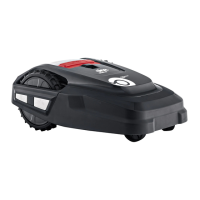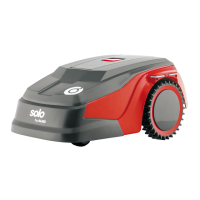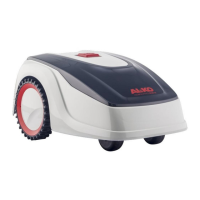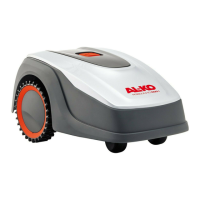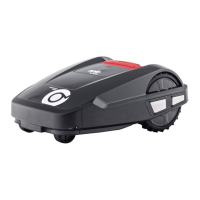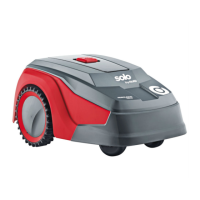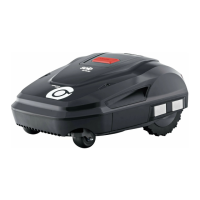495439_a 47
Assembly
IMPORTANT! Danger of damaging the
boundary cable. If the boundary cable is dam-
aged or cut, the transmission of the control sig-
nals to the appliance is no longer possible. In this
case, the boundary cable must be repaired or re-
placed. The boundary cables are available from
AL-KO.
■
Always route the boundary cable directly on
the ground. If necessary, secure with an ad-
ditional lawn peg.
■
When laying the boundary cable and during
operation, protect the boundary cable from
damage.
■
Do not dig or scarify in the vicinity of the
boundary cable.
1. Attach the boundary cable at regular intervals
with lawn pegs or route it underground (at a
max. depth of 10cm).
2. Route the boundary cable around obstacles:
see chapter 4.5.3 "Excluding obstacles",
page47.
3. Create corridors between individual mowing
areas: see chapter 4.5.4 "Enclosing corridors
(05/h)", page47.
4. Exclude excessive upward or downward
slopes: see chapter 4.5.5 "Excluding down-
ward slopes (15)", page47.
5. Create loops of cable: see chapter 4.5.6
"Creating loops of cable (11)", page48.
6.
After completing the routing of the boundary
cable, connect to the connector (07/B) of the
base station: see chapter 4.5.1 "Connecting
the boundary cable to the base station (07/b)",
page46.
4.5.3 Excluding obstacles
Depending on the surroundings of the working ar-
ea, the boundary cable must be routed at differ-
ent distances to obstacles. Use the ruler that can
be removed from the packaging to determine the
correct distance.
NOTE Exclusions are only necessary if
they cannot be detected by the bump sensors of
the appliance. Avoid too many or unnecessary
exclusions. Recesses that are smaller than 6 cm
must be excluded, otherwise the appliance may
cause damage.
Distance from walls, fences, beds:
min.20cm(05)
The appliance moves along the boundary cable
with an offset of 20cm to the outside. Therefore,
route the boundary cable at a distance of at least
20cm from walls, fences, beds, etc.
Distance from terrace edges and paved
paths(09)
If the terrace or path edge is higher than the
grass surface, a distance of at least 20cm must
be complied with. If the edge of the terrace or
path is at the same height as the grass surface,
the cable can be routed exactly along the edge.
Distance of obstacles from the boundary
cable(05)
If the boundary cables are precisely folded up
away from the obstacle or towards the obstacle,
i.e. distance 0cm, the appliance moves beyond
the boundary cable. Do not cross the boundary
cables (06/c), but lay them parallel (05/e).
Routing the boundary cable around
corners(05, 10)
■
For inwards going corners (10/a): Route the
boundary cable diagonally to avoid the appli-
ance becoming caught in the corner.
■
For outside corners with obstacles (10/b):
Route the boundary cable in a point in order
to avoid a collision of the appliance with the
corner.
■
For outside corners without obstacles(05/j):
Route the boundary cable at an angle of 90°.
4.5.4 Enclosing corridors (05/h)
In the corridor the following distances must be
complied with:
■
Total width: min. 60cm
■
Distance of the boundary cable to the edge:
20cm
■
Distance between the boundary cables: min.
20cm
4.5.5 Excluding downward slopes (15)
Downward slopes that are greater than the val-
ues specified in the technical data must be ex-
cluded with the boundary cable (45% = 45cm
downward slopes per 1m horizontally) (see tech-
nical data).
The boundary cable must not be laid over a gra-
dient of more than 20%. In order to avoid prob-
lems when turning, maintain a distance of 50 cm
to the 20% gradient. If the gradient at the outer
edge of the working area is more than 20% at
any point, lay the boundary cable on the flat
ground at a distance of 20 cm from the start of
the gradient.
